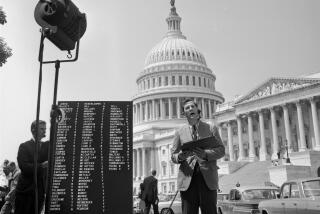A tale of two narratives
- Share via
The most famous speech in American history begins this way: “Four score and seven years ago our fathers brought forth on this continent, a new nation, conceived in liberty and dedicated to the proposition that all men are created equal.” Lincoln’s eloquence at Gettysburg was lyrical but not historically accurate. For no such thing as a “new nation” had been proposed in 1776; only a temporary union of sovereign states, declaring their independence from Britain, then presumably going their separate ways.
Indeed, the magic words of the Declaration of Independence to which Lincoln referred, Thomas Jefferson’s words starting with “We hold these truths to be self-evident,” located sovereignty in neither the national nor state governments but in the souls of individual citizens. Taken literally, this was a recipe for anarchy. Taken seriously, this meant that any robust expression of government power was put on the permanent defensive. Government was “them,” not “us.”
During the summer of 1776, then, the libertarian and anti-government values currently embraced by the “tea party” conservatives were, in fact, central features of the founding moment of the United States. While evangelicals will have a very hard time claiming Jefferson as one of their own, the original ethos of the American Revolution is, at least rhetorically, compatible with the political agenda of the contemporary conservative movement.
Of course there was a second founding moment in 1787, when a more expansive role for government was enshrined in the Constitution, and a framework created to sustain a dialogue about that role.
Then there was, in effect, a third founding, in the wake of the Civil War, which established the supremacy of the Union over the states (this was why Lincoln reinterpreted the American Revolution in the Gettysburg Address). As historian James McPherson has so nicely put it, after the Civil War the term “United States” became a singular rather than plural noun.
Finally, at the dawn of the 20th century, both Theodore Roosevelt and Woodrow Wilson led another expansion of federal authority, eventually consolidated in Franklin D. Roosevelt’s New Deal. FDR explained it best in his 1932 Commonwealth Club address in which he described the end of the frontier, the shift from an agrarian to an industrial society and the social and economic inequalities and dislocations generated by laissez-faire capitalism (that is, the Depression) as developments requiring what we now call the liberal state. Government had become “us” rather than “them.”
This brief tour of American history, which could be extended to include Lyndon B. Johnson’s Great Society, reveals that modern-day conservatives have “the spirit of ‘76” on their side, as well as the power of Jefferson’s original formulation of the American creed. Liberals, on the other hand, have the arc of American history on their side, which until the presidency of Ronald Reagan seemed to have the final word in the debate. After all, who could imagine a successful political movement requiring the revocation of two centuries of American history? Barry Goldwater, who campaigned for president in 1968 on just such a radical agenda, received only 38% of the vote.
While realistically this is still so -- unless American voters are prepared to dispense with Medicare, Social Security, the Federal Reserve Board and even our existence as a sovereign nation-state -- at least rhetorically conservatives have a narrative advantage. That is, their story of individual freedom and tyrannical government enjoys a privileged place in the lexicon because of its association with our political origins.
As a historian of those origins, I can tell you that there were dissenting voices back in the summer of 1776, most notably George Washington and John Adams, who regarded Jefferson’s dream of pure self-government as a preposterous illusion. Washington even thought that we almost lost the war for independence because of the refusal of the states to provide sufficient support for the Continental Army.
But the dream has proved remarkably resilient because it depicts any conspicuous expression of government power as an alien force and sanctifies the sovereign individual, standing tall against oppression. Even though that story line has been anachronistic for more than a century, it has levitated out of space and time to become a fixture in American mythology, never to be underestimated as a political weapon, especially when wielded by the party out of power.
As Thomas Frank showed in “What’s the Matter With Kansas?,” lots of Americans vote their convictions rather than their interests. And the most potent conviction in American history has authentic historical origins in the summer of ’76. FDR found a way to offer an alternative narrative for the 20th century.
If he is to win reelection, President Obama needs to do the same for the 21st.
More to Read
Sign up for Essential California
The most important California stories and recommendations in your inbox every morning.
You may occasionally receive promotional content from the Los Angeles Times.










